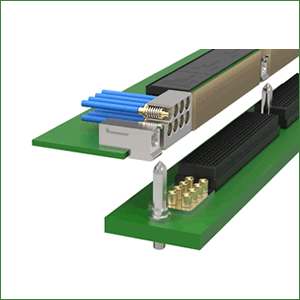New Developments in VITA 67 Connectivity
VPX open architecture is shaping new radar and electronic warfare platform designs.
By Michael Walmsley, Global Product Manager, TE Connectivity
Today’s military applications detect and track targets at faster speeds and longer ranges using active electronically scanned array (AESA) radar, which has placed new demands on radio frequency (RF) signal processing. In response, fire control AESA radar upgrades require a computing platform with a higher-density, higher-performance RF interface. An open computer bus standard known as VPX (ANSI/VITA 46) provides scalable backplane technology that includes a robust, high-speed, and high-density RF solution. As a result, VPX open architecture is being adopted in many new radar and electronic warfare (EW) platform designs.
To interconnect RF channels on the VPX backplane, the VITA 67 coaxial standard was developed to define a high-fidelity RF solution, featuring modules that can be positioned along with optical, signal, and power options within a slot.

A cutaway view of a VITA 67.2 application with a float-mounted SMPM contact
In the VITA 67.1 and 67.2 standards, subminiature SMPM series blind-mate connectors provide the multicoaxial RF backplane connection system. The VITA 67 RF module design positions the SMPM contact interface within robust stainless steel or aluminum modules that hold four (VITA 67.1) or eight (VITA 67.2) contacts. The spring-mounted contacts on the plug-in side of the card take up axial tolerances between boards within the chassis architecture. This assures that the contacts bottom when mated and maintain excellent RF performance under many rugged environmental conditions.
However, just as RF systems have evolved, so too has VITA 67. Recent upgrades in missile defense/control, surveillance, signal processing, and communication systems demand more speed and more channels in less space, which in turn requires more compact, lighter-weight connectivity to enable high-speed serial communications. For next-generation board-to-board interface designs, serial interconnects must support high-speed, high-fidelity I/O without sacrificing board space.
The VPX architecture defines formats for both 3U and 6U boards. These two formats share the same width (slot sizes), but the 3U plug-in board height is 100mm versus 233mm for the 6U. With advances in processor technology driving higher data rates and increasing I/O, there is greater opportunity to package high-performance computing modules in smaller 3U packages while achieving unprecedented functionality. So, the push to reduce size, weight, and power (SWaP) is stronger than ever. The tradeoff between size and functionality can be minimized if 6U-level connectivity can be built into a 3U board to meet the demand for higher density and speed.
VITA 67.3, which reverses the interface of the SMPM contacts, putting the float on the backplane contacts and leaving the contacts at the plug-in card stationary, will be released soon, and will enable direct termination (e.g., edge launch) to the plug-in carrier board, freeing up space within the plug-in computing module by eliminating cables.
Cabling with VITA 67.3 is also still an available option, as the standard does not define the termination, just the interface. VITA 67.3 also allows designers to define the coaxial contact positions within the machined module to suit specific applications. Plus, the standard offers taller connector module profiles that support one-inch slot pitches within a VPX chassis. The combined result of these features is a reduction in the utilized real estate within the plug-in module, achieved by eliminating cabling, as well as more options for increasing the contact count within a module along the edge of a board.
Direct board termination can be accomplished through an edge launch plug mounted on the daughter card. A bullet (i.e., jack-to-jack adapter) fits between the edge launch plug and the VITA 67.3 contact interface to take up positional tolerances and minimize stresses on solder joints.
VITA 67.3 will call for smaller contacts for increasing contact density. The VITA 67.3 standard has a framework to enable new contact interfaces to be added, and the increase in interconnect density will also come with a speed boost. Within a half-size VITA 67 module, eight or more RF contacts can support 60GHz compared to today’s four RF VITA 67.1 contacts at 26.5GHz.
The VITA 67.3 standard enables tighter system packaging and flexibility to create tomorrow’s higher density RF interfaces. The VPX roadmap will also reach 25Gb/s data rates (up from today’s 10Gb/s) for digital channels, providing a significant increase in bandwidth. Additionally, the density of optical modules is increasing, with up to 48 optical fibers within a half module. This evolution in connectivity helps meet the increased speed, density, and robustness that are required to achieve the radar and EW platforms of the future.
Mike Walmsley, Global Product Manager
 Mike serves as a Global Product Manager for TE Connectivity’s Aerospace, Defense & Marine business unit. Mike has more than 30 years’ experience with TE Connectivity and, previously worked with AMP Inc. Most of his time has been spent in engineering and product management with an emphasis on new product development. For the last four years, Mike has been with TE’s Aerospace Defense & Marine Business unit as a senior product manager for high-speed backplane and RF connectors.
Mike serves as a Global Product Manager for TE Connectivity’s Aerospace, Defense & Marine business unit. Mike has more than 30 years’ experience with TE Connectivity and, previously worked with AMP Inc. Most of his time has been spent in engineering and product management with an emphasis on new product development. For the last four years, Mike has been with TE’s Aerospace Defense & Marine Business unit as a senior product manager for high-speed backplane and RF connectors.
Recently posted:
[related_posts limit=”10″]








